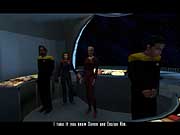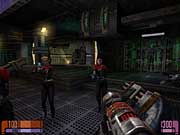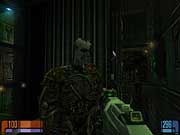Star Trek: Voyager Elite Force Preview
Amer Ajami finishes Elite Force and beams back some critical information on this Quake III-powered game.
Raven Software is about to become one of the first developers to release two successful first-person shooters in the same year. Hot on the heels of the company's popular Soldier of Fortune is Raven's Elite Force, a Quake III-powered shooter based on the Star Trek Voyager television series. And if the latest build sent to us by Activision is any indication, then Raven looks as though it has another winner on its hands. Earlier this week, we played through the entire game, and even though certain gameplay elements are still missing from Elite Force, the game is completely playable, and it gave us a good idea of how the final product will shape up.

Like the TV show it's modeled after, Elite Force initially takes place aboard the Federation Starship Voyager as it continues its journey back to Earth from the Delta Quadrant. Upon receiving a distress call from a derelict alien probe, the Voyager finds itself under attack - the victim of a trap - and is forced to return fire. Voyager manages to destroy the alien ship, but the resulting shockwave from the explosion causes a rift in the space-time continuum, sending Voyager into a mysterious starship graveyard with no way to escape. It's revealed later on in the game that an alien species known as the Reavers constructed a massive space station called the Forge, which creates a dampening field that prevents escape from the graveyard. Any race advanced enough to defeat the derelict probes are sent to the graveyard, and their technology is then assimilated into the Reavers' own, much like the way the feared Borg operate. But even the Borg can't seem to adapt to the Reavers' technology, as they too took the bait and now find themselves trapped within the confines of the graveyard.

Voyager's Captain Janeway puts into place a series of plans to get her ship back into operational status and find a way to break the clutches of the graveyard. One of the key elements of Janeway's plans is the Hazard Team, an away team that comprises the ship's most elite Federation officers, who have been handpicked by Tuvok, Voyager's head of security. You assume the role of Ensign Alex Munroe, the levelheaded second-in-command of Hazard Team. As you jump from ship to ship, you rally the aliens who've also fallen victim to the graveyard against the Reavers and the Forge. Most of the missions are played as part of a squad, and while you won't be able to control your team members, the other Hazard Team officers are competent enough to not accidentally shoot you in the back or to keep themselves from getting stuck behind walls. During some of the later missions, you'll even be joined by some of the Voyager crew from the TV show, like Seven of Nine and Tuvok.
The World of Elite Force
Elite Force is split up into roughly 30-plus single-player levels, and it's clear that the developers at Raven took cues from Half-Life in its design. Limited supplies of ammunition and health are dispensed by wall-mounted stations, which are found throughout the game's alien ships (while you're aboard Voyager, the holographic doctor administers medical aid to you). Level transitions also occur in a manner reminiscent of Half-Life in that you don't realize that you're about to enter a new area until the "now loading" text appears across your screen. To preserve suspension of disbelief, the progress meter of the level load time is displayed as a transporter icon going through the motions of locking onto your position and energizing.

Raven has also included the same style of scripting sequences that made Half-Life so popular in Elite Force, albeit with a slight twist. Scripted events in the game are somewhat interactive, and you'll be given the power to affect their outcome by simply interfering with them. For example, during one of the earlier missions that take place aboard the Voyager itself, you'll hear an engineer desperately asking you to activate a containment field in a hallway in order to contain an imminent explosion. At this point, you can choose to run past the explosion's path (at the cost of a handful of the crew's lives) or you can turn on the field and save the lives of your crewmen. You can also opt to activate the field before or after the engineer clears the hallway - both actions will contain the blast, but the former provides you with a great view of the engineer getting caught between the explosion and the force field. The developer has even manipulated the Quake III engine to physically change the layout of certain rooms as part of this unique brand of scripted sequences. Explosions will cause hallways and rooms to break apart, which will reveal previously inaccessible areas.

Each of the game's 30 single-player levels take place aboard either the Voyager or one of the five different alien spaceships that the Hazard Team will be sent to. These levels are extremely varied in their design to reflect the different alien cultures of the game, which include the Etherians, the Borg, the scavengers, and the Reavers of the Forge. The Quake III engine's rendering capacity shines in some of the more organic levels, as Raven has made full use of graphical effects like curved surfaces and scripted levels. Where the graphics of Elite Force really impresses, however, is in the weapon effects.
Weapons
Like most first-person shooters, it's obvious that a majority of the Elite Force's design went into creating visually stunning, visceral weapons. The game has a total of nine ranged weapons (Elite Force has no melee weapons) that are available in both the single-player campaign and Holomatch multiplayer mode. Each of the following nine weapons, presented over the next two pages, has a primary and secondary mode of fire, and each can be used in conjunction with your Federation viewfinder, which is in essence a scope.
Phaser: This standard issue sidearm has been a Star Trek staple since the days of Kirk and company. It fires a persistent beam of energy that causes a considerable amount of damage. The alternate fire mode is even more powerful, but it expends a lot of ammunition. While keeping a moving target within the phaser's reticle is difficult, the weapon's ammo is rechargeable, so you won't have to worry about wasting any shots. Unlike the phasers depicted in the Star Trek TV shows and movies, this one doesn't have a stun setting.
Phaser compression rifle: This weapon has also been featured in previous episodes of Star Trek. Its primary mode of fire discharges the same beam energy used by the phaser in rapid bursts. The secondary method fires a single blast of concentrated energy with deadly accuracy. One hit using the phaser compression rifle's secondary mode of fire can kill almost any creature in the game. Unfortunately, this uses six times the ammo consumption of the rifle's standard firing mode.
Infinity modulator: Developed by Seven of Nine to combat the Borg's adaptive technology, this weapon fires a powerful burst of energy whose frequency is constantly changed, making it impossible to be deflected by the Borg's shields. While its rate of fire is slower than the compression rifle, each shot is extremely accurate and very powerful. The I-Mod's secondary mode fires an even more powerful shot that requires a lengthy recharge time, similar to the railgun in Quake III.
Scavenger rifle: This weapon, developed by the scavengers of the Forge, is an arcane rifle that has two truly distinct modes of fire. The first fires red bulletlike bursts of energy from two different barrels. While the rate of fire is fast, the red pellets do a limited amount of damage. For added power, the scavenger rifle has a grenade launcher attached to it, which lobs balls of energy that cause splash damage in a parabolic arc.
Statis weapon: You'll find this weapon aboard the Etherian spaceship during the single-player campaign. The statis weapon is actually a living creature that emits forks of lightning in rapid bursts and fits snugly over your character's hand. It can also fire a wide spread of lightning energy at once as its secondary mode. The statis weapon was designed by the Etherians, and ironically, it's the most effective tool you'll find to defeat them.
Compound grenade launcher: This rifle is no different from any other FPS grenade launcher. In its primary role, it lobs an unpropelled Federation grenade that explodes after a few seconds after it comes in contact with a player or NPC. It can also fire, at an astonishingly fast rate, timed mines that stick to any surface.
Tetryon pulse disruptor: While inaccurate from afar, the Tetryon pulse disruptor can be deadly at close range. It's best described as a rapid-fire shotgun, which is dropped by a Hirogen assassin in the single-player missions. Its secondary mode fires a ball of green energy that travels at high speeds and bounces off walls and solid objects, which makes the Tetryon pulse disruptor dangerous to use in tight areas.
Photon burst: The photon burst is easily the most amusing weapon in Elite Force. It's basically a portable photon torpedo launcher that fires a salvo of torpedoes, which look and sound remarkably like the ones used by the Federation starships. Needless to say, one shot from this weapon will incinerate nearly anything in its sight. For added firepower, the photon burst can fire an even more powerful torpedo that does extensive damage, but one that lacks the speed and the distance of the weapon's primary ammo.
Arc welder: The most powerful weapon in Elite Force isn't a weapon at all. The arc welder is a construction tool that you'll find late in the game. It fires a bolt of electricity much like Quake III's lightning gun and does a tremendous amount of damage. Its secondary mode of fire emits a ball of lightning that zaps nearby enemies - not unlike the BFG10K in Quake II.
Additionally, Elite Force will have a number of Holomatch items that go a long way in adding new facets to the tired multiplayer fragfest formula used by nearly every first-person shooter. Key among these items is the personal force field, a portable device that, when deployed, activates a temporary force field that deflects weapon fire, but allows players to pass through unabated. This item can be placed anywhere on any given map and proves extremely useful for defending bases and flags from enemy fire. Other items include a detpack, which is something of a mini-nuke that instantly kills anyone within its large blast radius, as well as the standard personal transporter, medkit, and the damage amplifier. Elite Force should have around ten Holomatch maps with three different multiplayer modes of play: deathmatch, team deathmatch, and CTF. Earlier this year, Raven told us that the team was hoping to include an assimilation mode that would pit a team of Borg players against a team of Federation officers. Even though it sounds intriguing, it doesn't look as though Raven will include this mode with Elite Force.
Our build is nearly complete, but it's clear that there are still some problems with Elite Force that Raven needs to hammer out. Enemy placement in later levels seems somewhat sporadic, and it isn't as logical as in the earlier levels in the game. Additionally, several of the missions in the scavenger levels are supposed to be stealth missions, but enemies will attack you without any provocation, which makes the need for stealth useless. There are also some problems with volumetric coronas shining through solid walls and objects. However, the team is now entering crunch mode - the final weeks of development - and these problems should undoubtedly be addressed in the retail version of Elite Force.
Got a news tip or want to contact us directly? Email news@gamespot.com
Join the conversation